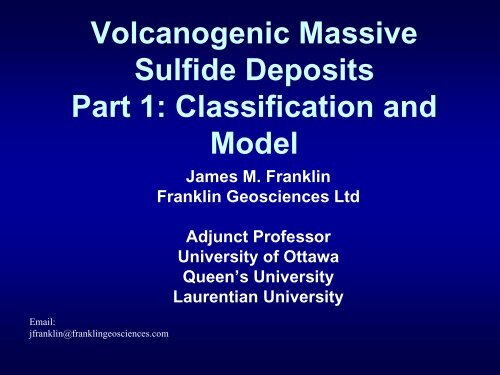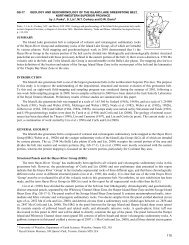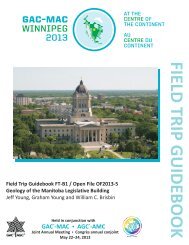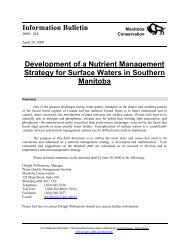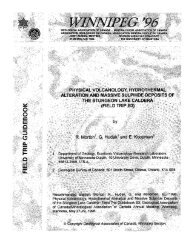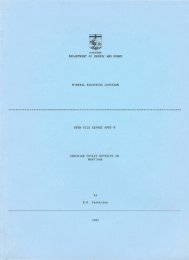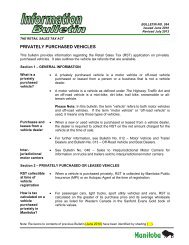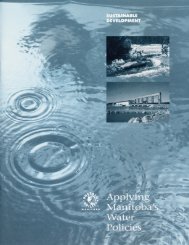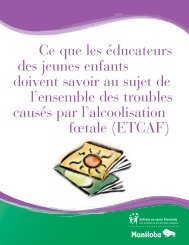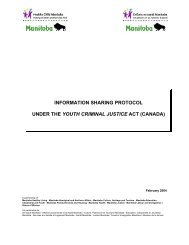Classification and Key Characteristics of VMS Deposits
Classification and Key Characteristics of VMS Deposits
Classification and Key Characteristics of VMS Deposits
You also want an ePaper? Increase the reach of your titles
YUMPU automatically turns print PDFs into web optimized ePapers that Google loves.
Contributors (Alphabetical)• D. Ames, Geological Survey <strong>of</strong> Canada• T. Barrie, T Barrie <strong>and</strong> Associates, Ottawa• CODES Team (R. Large, B. Gemmel et al)• A. Galley, Geological Survey <strong>of</strong> Canada• H. Gibson, Laurentian University (MERC)• W Goodfellow, Geological Survey <strong>of</strong> Canada• M. Hannington, University <strong>of</strong> Ottawa• I. Jonasson, Geological Survey <strong>of</strong> Canada• J. Peter, Geological Survey <strong>of</strong> Canada• R Sherlock, Miramar Mining Ltd
Major Volcanogenic Massive Sulfide Districts <strong>of</strong> the World• World-wide contain about $500 billion in contained metal value• Sustain much <strong>of</strong> the world’s supply <strong>of</strong> zinc <strong>and</strong> silver, importantsources <strong>of</strong> Cu, <strong>and</strong> are a major source <strong>of</strong> “high tech” metals (Ge, In)• Occur in strata <strong>of</strong> all ages
Sources <strong>of</strong> Information• Studies <strong>of</strong> Ancient <strong>Deposits</strong>– Precambrian Shield– Kuroko (Japan)– Paleozoic in Canada <strong>and</strong> Australia– Lower Cretaceous in Peru <strong>and</strong> Mexico– Mesozoic-Cenozoic in Cyprus, Oman• Modern Hydrothermal Systems on theSeafloor– Spreading ridges– Back-Arcs <strong>and</strong> Arcs
The Challenge: Some Belts are Rich• Exceptional valuein specific tectonicareas <strong>of</strong> highpotential shouldlead to explorationinvestment inthese areas• Why are somebelts so wellendowed (Abitibi,Trans-Hudson,Slave) <strong>and</strong> othersnot (Wabigoon,Grenville) ??<strong>and</strong> Others Aren’t… Why?
<strong>VMS</strong> Model• What are the key geological processes thatenable the formation <strong>of</strong> productive districts?• Are any <strong>of</strong> these evident in the geological record?• Are these key criteria evident on geological maps,or must we conduct specialized studies toestablish there presence?• What can we learn from other districts?In summary….• What’s the <strong>VMS</strong> “model” about? What can welearn from it?
Bottom to Top- Some ImportantGuidesWhat are the mostimportant guides?Regional Guides•Subvolcanic Intrusions•Volcanological Style•High Temperaturereaction zones•Exhalite zonesLocal Guides•Alteration pipes•Ore zoning patterns
HydrothermalEscapePrecipitationSiteDischargeZoneReservoirCapReaction ZoneHeat Source
Evolution <strong>of</strong> theHydrothermal System1: Subvolcanic intrusionemplaced;2: Heat from intrusion raisestrapped seawater temperaturecausing dissolution <strong>of</strong> Si;3: Cold seawater descends,meets rising HT water, Mg +Sippt forming “cap” to reactionzone4: Reservoir zone becomesisolated from seawater influx,becomes isothermal ~380 o C5: High-T water : rock reactionliberates metals, sets pH ~3.0,forms qtz-epidote-actinolitealbiteassemblage
Five <strong>VMS</strong> Lithotectonic Settings•1: Bimodal mafic-dominated volcanic– Ocean-ocean suprasubduction arc• 2: Mafic backarc: mafic volcanic dominated,ophiolite-associated– Oceanic backarc <strong>and</strong> mid-ocean rifts– Some plume-related (including alkaline) volcanics• 3: Pelitic Mafic backarc: sediment, mafic flow/silldominated– Oceanic backarc-rift; pelagic sediments• 4: Bimodal felsic-dominated volcanic– Ocean-continent suprasubduction arc• 5: Siliciclastic- Felsic– Ocean-continent backarc; continental-derived sediments
1: <strong>VMS</strong> <strong>Deposits</strong>: Copper-Rich <strong>Deposits</strong>• Ocean-Ocean Arc -Backarc Terrains– Initial Arc Splitting• 50% mature sedimentary rocks (pelite) in Besshi-type, orophiolite (Cyprus-type)• No (or >1%) felsic rocks• Laterally extensive, Co-enriched Cu ± Zn ±Au• Examples– Windy Craggy (Canada), Besshi, Oman, Cyprus
2: <strong>VMS</strong> <strong>Deposits</strong>: Zinc-Lead-Rich <strong>Deposits</strong>• Ocean-Continent Arc -Backarc Terrains– Steep Subduction– Initial Arc Splitting• >50% felsic volcanic strata• Pyroclastic dominated, at caldera margins• Zn-Pb-Cu <strong>Deposits</strong>• Examples:– Kuroko (Japan); Skellefte, Bergslagen (Sweden)– Mature Arc Splitting• >50% mature sedimentary rocks (greywacke)• Felsic pyroclastic strata, minor basalt• Low grade Zn-Pb +/- Cu• Examples– Bathurst district (Canada), Iberian Pyrite belt
SubductionDynamics•Must have slab rollback•Need dense,dehydrated, cooloceanic crust to beeffective•Should be distal tospreading ridge
Excellent Oceanic BackarcPotential for Nor<strong>and</strong>a,Besshi, ophiolite typeTonga KermadecArc•Northern End (Lau Basin)•Classic Mature Ocean-Ocean Backarc•Good potential forNor<strong>and</strong>a-style depositsOcean-ContinentbackarcPotential forKuroko, Iberiatypes•Southern End (Havre Trough)•Underlain by continentalcrust•Good potential formKuroko-style deposits
Tectonic Controls on <strong>VMS</strong> <strong>Deposits</strong>- Summary• Paleo-Tectonic Environment– Best back-arcs form where older, cooler (somewhatdehydrated) more dense oceanic crust was subducting• steeper subduction, continental retreat lead to<strong>of</strong>fshore, classic oceanic isl<strong>and</strong> arc <strong>and</strong> back arcdevelopment: Lots <strong>of</strong> <strong>VMS</strong>– Proximity to paleo-oceanic spreading ridge is important• too close (e.g. EPR to S. America) yields hot,hydrated, buoyant subducted oceanic crust, formingcontinental arcs: No <strong>VMS</strong>, lots <strong>of</strong> epithermal &porphyry deposits– Very old, cold, thick oceanic crust, including oceanicplateaus, may not subduct: No oceanic arcs, backarcsor <strong>VMS</strong>• e.g. Ontong -Java plateau locked against New Irel<strong>and</strong>arc, subduction shifted
Median Metal Content (Millions <strong>of</strong> Tonnes/Kg)GEOMETRICMEAN1:BimodalMafic2:MaficBackarc3:Pelitic-Mafic4:BimodalFelsic5:SiliciclasicFelsicCu % 1.24 1.82 1.23 1.04 0.62Pb % 0.3 0.02 0.68 1.14 1.09Zn % 2.32 0.84 1.58 4.36 2.70Au g/t 0.81 1.40 0.75 1.06 0.59Ag g/t 21.14 10.62 19.29 56.35 38.54TOTAL METAL(TONNES) 128,515 63,035 132,968 198,461 324.748TOTAL SULFIDE(TONNES) 3,421,075 2,699,466 4,721,093 3,420,784 7.139,305N 291 76 90 241 1062007
Normalized Metal Contents <strong>of</strong>Principal <strong>VMS</strong> Types
Metal Correlation MatrixCu Pb Zn Au AgCu 1Pb -0.921 1Zn -0.756 0.757 1Au 0.695 -0.745 -0.327 1Ag -0.659 0.773 0.953 -0.286 1
<strong>Characteristics</strong> <strong>of</strong> the Five Types <strong>of</strong> <strong>VMS</strong>• Although types are distinct, significant variationsexist within each type• Compositional characteristics are specific• Physical volcanological characteristics vary,depending on water depth, melt volatile contents• Greatest variations in Bimodal mafic <strong>and</strong>Bimodal felsic types• Bimodal mafic can be divided into twosubgroups:– 1A: flow dominant, Zn-Cu, form on seafloor– 1B: pyroclastic dominant, Zn±Pb, Cu, Ag, form subseafloor
Bimodal mafic: Comparison <strong>of</strong> SubtypesFlow dominated• Higher Cu, noPb• Lower totalmetal content
Type 1A:Bimodal mafic-dominated (flow)• Setting: Ocean-ocean arc, nascent (early) arc rifting– Median Size <strong>and</strong> Composition: 2.8m.t., 1.41 Cu, 2.6 Zn,0.1Pb, 0.8 g/t Au, 22 g/t Ag– Geology: >75% pillowed tholeiitic basalt-<strong>and</strong>esite,
Nor<strong>and</strong>a Cross Section
Nor<strong>and</strong>a Camp: Bimodal Mafic-Dominated setting (1a)HorneAnomalous because:>25% felsicstratamany shallowintrusions, flowdomesNo pyroclasticsformed eitheroutside calderon oron its marginmore sediment totrap precipitates
• Snow Lake- two major <strong>VMS</strong>episodes, twosubtypes• late: Zn-Pb-Cu-Au, BimodalFelsicPyroclasticdominated(Chisel-Ghost)• early: Cu-Zn,Bimodal Maficdominated(Anderson-Stall)
Kidd Creek vs. Potter MineContrasting settings in the samegreenstone beltBoth with strong ultramaficvolcanic associationKidd Creekhas a uniquesetting; Type1BPotter isBesshi/Ophiolitestyle: Type 1A
Typical Nor<strong>and</strong>a-type Deposit•Sulfide mound formed on seafloor: Zn-Cu, low (1 g/t) Au•Many with Fs-porphyry dykes in FW, occupy synvolcanic fault•Several in / on felsic cryptodomes•Some detrital (talus) sulfide on margin•Very vertically extensive stringer - alteration zone•Chlorite-quartz core, sericite outer margin
Type 1B:Bimodal mafic-dominated volcaniclastic• Setting: Ocean-ocean arc, nascent (early) arc rifting– Median Size <strong>and</strong> Composition: 4.5m.t., 1.1 Cu, 3.4 Zn,0.8 Pb,1.1 g/t Au, 37 g/t Ag– Geology: >75% pillowed tholeiitic basalt-<strong>and</strong>esite,
Sturgeon Lake District: Example <strong>of</strong> Type 1BCamp Size20.42 mt 8.25% Zn;0.76% Pb; 0.97% Cu109g/t Ag
Sturgeon Lake Geology
Sturgeon LakeBimodal mafic 1BPyroclasticdominatedCaldron sequence:•base <strong>of</strong> sequencesubmarine<strong>and</strong>subaerial basalt•episodic calderacollapse:heterolithicdebris flow•deposits formed atonset <strong>of</strong> felsicvolcanism•cryptodome formedafter deposits•Andesitic HW
Mattabi deposit: Five stratiform lenses, b<strong>and</strong>ed sphalerite-galena pyrite,minor stringer zone, late cpy-asp-tetrahedrite zone
Type 2: Mafic-Backarc (ophiolite)• Setting: Mature ocean-ocean backarc, oceanicspreading ridges– Av. Size <strong>and</strong> Composition: 2.7 m.t., 1.8 Cu, 0.84 Zn,0.02 Pb, 1.4 g/t Au, 11 g/t Ag– Geology: Tholeiitic: MORB to LILE <strong>and</strong> LREE-enriched, ocean isl<strong>and</strong> basalt– Ore: Massive sulfides bulbous pyritic, low As, Sb, Sn;prominent Cu-stringer zones.– Pipe alteration: pronounced, zoned Fe -Mg chloritecore, sericite+/- paragonite rim ; silicic veins– Semiconformable: Epidote-albite-actinolite, localsilicification; regular metal depletion– Examples: Cyprus, Oman, Lokken (Norway)
Ophiolite-hosted•Usually formed in matureoceanic backarcs•May be obducted oceanicspreading ridges•Productive areas haveplagiogranite in thesubvolcanic sequence•biggest deposits low instratigraphic section•Au-rich caps generallyoverlooked by early miners
Type 3: Pelitic - Mafic Backarc (Besshi)• Setting: Mature ocean-ocean backarc– Av. Size <strong>and</strong> Composition: 4.7 m.t., 1.2 Cu, 1.6 Zn, 0.7Pb, 0.75 g/t Au, 19 g/t Ag– Geology: pelitic to semi-pelitic distal, minor siliciclasticsediments. Tholeiitic basalt, MORB to LILE <strong>and</strong> LREEenriched, ocean isl<strong>and</strong> basalt– Ore: Massive sulfides tabular, pyrite & pyrrhotite, lowAs, Sb, Sn; high Co (+/- Ni?), minor Cu-stringerzones.Some sulfidic sediments, chert, IF.– Pipe alteration: zoned Fe -Mg chlorite core, sericite;– Semiconformable: not well established– Examples: Besshi, Windy Craggy
Besshi-Type (Mafic-Dominated Siliciclastic)
Type 4: Bimodal felsic-dominated• Setting: Ocean-continent arc, nascent arc rifting– Av. Size <strong>and</strong> Composition: 3.4 m.t., 1.0 Cu, 4.4 Zn, 1.1Pb, 1.1 g/t Au, 56 g/t Ag– Geology: 35%pillowed tholeiitic to calc-alkaline <strong>and</strong>esite, Felsic subvolc.intrusions, not prominent– Ore: Massive sulfides bulbous to tabular, pyritic, As, Sb,Sn variable; some Au-rich, local (late?) high-S zones;limited Cu-stringer zones.– Pipe alteration: pronounced, silicification <strong>and</strong> sericitedominant, zoned Fe -Mg chlorite core, sericite rim– Semiconformable: Lower albitic, upper K-spar rich, Nadepleted,uppermost zoned (Fe) carbonate– Examples: Kuroko, Skellefte, Sturgeon Lake, Buchans,Buttle Lake
•These are a “special case” <strong>of</strong> the bimodal-felsic-dominated class•There are two types•1:Unusual compositions: Boliden, Neves Corvo: possible direct magmatic input•High Hg, Sn, Te; unusual non-stratiform shapes, not high S•Unusually enriched in “high volatility “elements (Hg, Sb, As, S):•probable exceptionally high vapour-phase (boiling) systems•not really “high S” either!
Type 5: Felsic siliciclastic hosted• Setting: Mature ocean-continent backarc– Av. Size <strong>and</strong> Composition: 7.1 m.t., 0.6 Cu, 2.7 Zn, 1.1Pb, 0.6 g/t Au (?), 38 g/t Ag– Geology: Siliciclastic (volcanic +/- continent derived)sediments, locally prominent felsic pyroclastic flows,minor calc-alkaline mafic flows (typically H.W.)– Ore: Massive sulfides huge tabular, pyrite & pyrrhotite,variable As, Sb, Sn; minor Cu-stringer zones. Somewith IF, chert– Pipe alteration:variable size, usually minor, sericitic,silicic, Fe-chlorite– Semiconformable: not well established (K-rich upperzone, Na-rich (+epidote, actinolite) lower– Examples: Bathurst, Iberia, Kazakhstan, Bergslagen (?)
Bathurst Mining Camp: SedimentedBack-Arc Continental Rift BasinOceanicCrustSubductionZone <strong>and</strong>Isl<strong>and</strong> ArcBack-ArcRiftShelfL<strong>and</strong>Sea levelOHS 2 2Oceanic CrustAsthenosphereFelsicVolcanicsSyn-riftclasticsMassiveSulfidesBasinalsedimentsMagmaContinentalBasementSubductingOceanicCrustAsthenosphereUpwelling
Geology<strong>of</strong> theBrunswickDistrict
Bimodal Siliciclastic Environment
Summary• Cu-rich deposits form in primitive, basalt-dominant oceanic arcbackarcsystems: deep water• Zn-rich deposits form in epicontinental, felsic <strong>and</strong> sedimentdominantoceanic backarc systems• Subvolcanic intrusions are more common, <strong>and</strong> are commonlymafic or composite• High-T reaction (ep-ab-act-qtz) zones are metal depleted withsilicified caps (or carbonate in shallow-water systems): Theseprovide good indictors <strong>of</strong> potentially productive regions• Alteration pipes occupy synvolcanic faults: usually verticallyextensive, Mg-metasomatized, Na ± Ca depleted <strong>and</strong> Cu-rich• Cu-rich <strong>VMS</strong> typically form as mounds on the paleo-seafloor;extensive metal redistribution may result in Cu-rich core, Au ±Ba cap (post PC)• Zn-rich <strong>VMS</strong> form sub-seafloor, some metal redistribution,copper in limited stringer zones, Au-rich (cap), oxidized distalexhalite• Laterally extensive “exhalite” (chert or pelite) containsanomalous metals <strong>and</strong> conserved elements, useful as vectorsto ore


